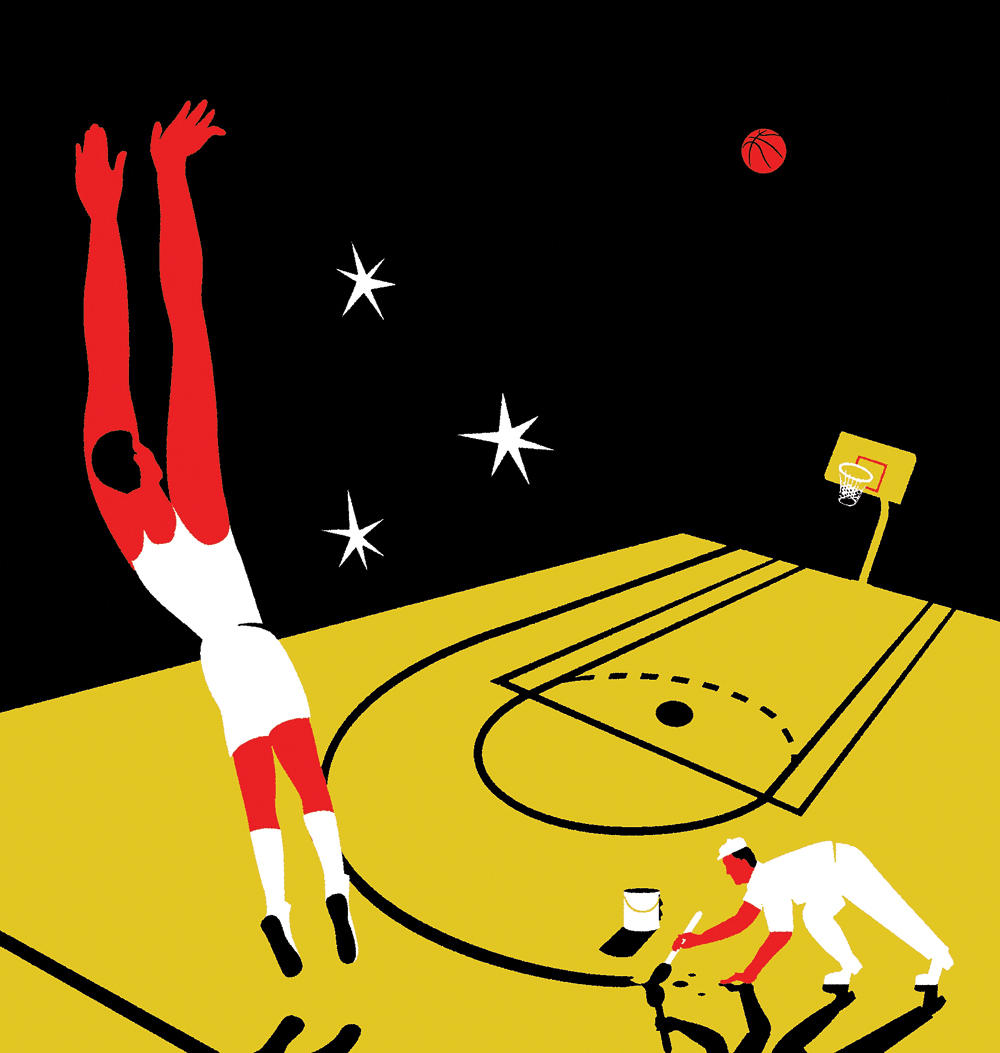It has become a matter of poetry: Golden State Warriors guard Stephen Curry dribbles down court, stops casually outside the three-point line, rises from the floor, raises the basketball near his head, flicks his wrist, and sends the ball arcing twenty-two feet or more over the court, where it whispers through the net: swish.
Curry, a two-time NBA Most Valuable Player, is the greatest practitioner of the three-point shot, and his coach, Steve Kerr, who played on championship teams with the Chicago Bulls and the San Antonio Spurs, holds the record for highest career three-point percentage. But each time fans marvel at Curry or others who excel at the three-pointer — perhaps the most important play in basketball — they are unknowingly paying tribute to an innovator who used the Columbia gym as his laboratory.
Howard Hobson ’45TC was best known as a pioneering college coach. He won 495 games as a coach, and in 1939 he guided the University of Oregon to the first-ever NCAA tournament championship. But his greatest contribution to basketball might have come on February 7, 1945, during a game between Fordham and Columbia. That night, in front of about a thousand people on the Columbia campus, the Lions and the Rams played the first college game with a three-point line, an experimental rule dreamed up by Hobson.
Forty-one years old at the time and on sabbatical from Oregon to get his doctorate in education, Hobson had spent thirteen years analyzing 460 basketball games. He was to collect these observations in his Columbia thesis, which he turned into the 1949 book Scientific Basketball. Today, few people remember Hobson’s basketball bible, but the ideas he put into practice in the Columbia game of 1945, laid out in chapter 10 of his book, are accepted wisdom. The three-point shot in particular changed the game forever. Like the home run in baseball, Hobson wrote, “the long field goal is the most spectacular play in basketball.”
The three-pointer, as opposed to the standard two-point shot, had the promise not only of being exciting to spectators, but of diminishing the advantage of taller players who could easily drop the ball in the bucket from close range. Previewing the history-making matchup in 1945, the New York Times wrote, “In an effort to make basketball a more interesting and wide-open game, the Columbia-Fordham contest tonight at the Morningside Heights gym will be played under new rules.”
Once the game began, the players loved the new long-distance shot, even if it sometimes confused them. Officials called several players for traveling violations when they forgot to dribble and simply ran out to the three-point line while carrying the ball.
Columbia won 73–58, hitting eleven three-pointers while Fordham made nine. Columbia’s John Profant knocked in four of the long shots, and teammate Norm Skinner ’50CC hit three of them while scoring twenty-six points. Some fans completed surveys about the alterations. The final tally came in with 148 in favor of the three-pointer, 105 against.
The new rule certainly boosted Columbia’s offense. Those seventy-three points set a school record for the Lions. In no other game that season did Columbia even reach sixty points. In the New York Herald-Tribune, Irving T. Marsh wrote, “To this observer the new rules definitely provided a game with more action and much more excitement, but if it really gets wild and woolly there is no telling what may happen.”
Other reporters took a harsher view. The Spectator complained about confusion, and an Associated Press writer asked, “What’s wrong with the old game?” New York Times scribe Louis Effrat noted, “The experts’ impression was that subordinating the lay-up shot by awarding an extra point for a long basket would minimize the value of team play. The experiment, therefore, was far from a howling success.” Effrat ended his story by predicting the three-pointer “will be permitted to die a natural death.”
And for many years, Howard Hobson’s favorite shot did seem destined to perish. But then the short-lived American Basketball League used the three-pointer for the 1961– 1962 season, and the longer-lived American Basketball Association instituted the shot in 1967. The NBA didn’t use it until 1979, and the NCAA made it a nationwide rule in 1986. Today, the three-pointer, which allows teams to build larger leads or overcome greater deficits in less time, is a pervasive weapon in basketball, as more teams take more shots from “downtown,” as the announcer says.
Hobson, who died in 1991 at the age of eighty-seven, advocated the three-pointer throughout his life, believing the play he unleashed in 1945 was the shot of the future. He did it modestly, though. In Scientific Basketball, Hobson wrote that coaches should try the three-point shot and “see if the results seem to be helpful to the game.” Coach Kerr of the Warriors would probably say yes.



